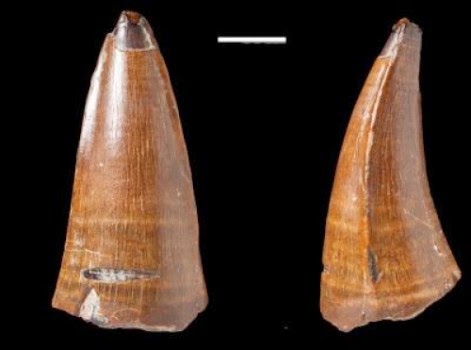
A fossilised tooth belonging to a fearsome marine predator has been recorded as the largest of its kind found in the UK, following its recent discovery.
A team of palaeontologists have verified the tooth, which was found near Chesil Beach in Dorset, as belonging to a prehistoric relative of modern crocodiles known as Dakosaurus maximus.
The tooth, which has a broken tip, is approximately 5.5 cm long.
Researchers and curators from University of Edinburgh and the Natural History Museum in London identified the item after it was bought at an online auction by a fossil collector.
Scientists say the circumstances in which the fossil was found were unusual — it was dredged from the sea floor rather than being found on the shore or dug up.
The tooth has been examined and identified by a team of UK palaeontologists and placed in the fossil collection of the Natural History Museum.
Dakosaurus maximus, which grew up to about 4.5 metres long, swam in the shallow seas that covered Europe some 152 million years ago. It belonged to a family of marine animals known as thalattosuchians, relatives of today’s crocodiles.
The unusual shape of the animal’s skull and teeth suggests it ate similar prey to modern-day killer whales. It would have used its broad, short jaws to swallow large fish whole and to bite chunks from larger prey.
The team’s research is published in the scientific journal Historical Biology.
Dr Mark Young, of the University of Edinburgh’s School of Biological Sciences, said: “Given its size, Dakosaurus had very large teeth. However, it wasn’t the top marine predator of its time, and would have swum alongside other larger marine reptiles, making the shallow seas of the Late Jurassic period exceptionally dangerous.”
Note : The above story is based on materials provided by University of Edinburgh.










